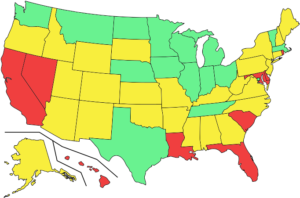Below is a map of the states that provide reciprocal admission on motion on a tit-for-tat basis (you get admission here we get a mission there). Twenty-six states have tit-for-tat admission on motion rules for experienced attorneys. We are looking for qualified attorneys from California who want to move elsewhere and can’t because of tit-for-tat rules, or attorneys in other states that do not provide reciprocal admission, or other attorneys who can’t get admission on motion in California because it does not provide admission on motion. We would prefer to target Arizona, Pennsylvania, or New Jersey tit-for-tat rules. However, we would consider seriously filing tit-for-tat challenges in other jurisdictions.
Based on recent Supreme Court precedent, we believe these tit-for-tat admission rules are clearly on unequivocally unconstitutional. Protectionism is also apparent in the jurisdictions that limit admission on motion to lawyers “from jurisdictions also offering admission on motion.”85 This reciprocal approach to admissions is not contingent on another jurisdiction’s admissions requirements, but rather focuses exclusively on whether the other state offers an admission on motion procedure. As a result, a novice lawyer from a “reciprocal” state could receive admission, whereas a much more experienced lawyer from a non-reciprocal state would have to re-take the entire bar examination. There is little, if any, justification for this discrimination that relates to attorney quality.
The primary explanation for imposing the full bar examination on the second lawyer while admitting the first on motion is to promote the economic interests of the in-state bar. Under the Constitution and Supreme Court precedent, economic protection is not a legitimate state interest. The Supreme Court has also expressly held that it will not presume that out-of-state attorneys will violate the rules of professional conduct or not keep abreast of local law if admitted in a second state.
Reciprocity for admission on motion to the state bar, by sort in the United States

Read More